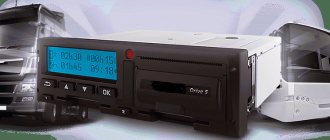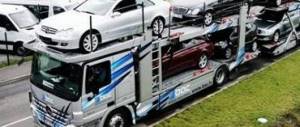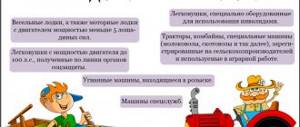Internal combustion engines, which operate by converting thermal energy into mechanical energy, negatively affect the environment by emitting combustion products and indestructible fuel components into the atmosphere. Already in the 1980s, the European community became concerned with the issue of a sharp increase in harmful emissions, which led to the emergence of an environmental standard for fuel and cars with internal combustion engines.
Russia, as one of the parties to the Geneva Agreement, has also introduced and regularly updates environmental standards regarding vehicles. But, despite the fact that the practice of their use has existed for more than 30 years, many still do not know what the environmental class of a car is, what parameters it is determined by, how it is regulated, how to find out the eco-class of a car, as well as about existing restrictions and possible sanctions for violating them. Let's try to tell you about everything in detail and in order...
Find out the environmental class by VIN number
Find out eco-class
What is a car’s environmental class and how many are there?
The European environmental class (EC) or Euro standard is a gradation of vehicles that reflects the amount of a number of substances, namely carbon monoxide, hydrocarbons and nitrogen oxide (CO, CH and NOx), emitted into the atmosphere by gasoline and diesel engines.
The first environmental standard introduced in Europe (1988) was Euro-0, and it applied only to gasoline engines and, in fact, determined the best indicators at that time, without regulating or limiting manufacturers.
If we express it in numbers, this means that during 3 months of operation in standard mode, the car consumes about a ton of oxygen, and the exhaust will produce about:
- 200 kilograms of carbon monoxide;
- 50 kg carbons;
- about 10 kg of nitrogen oxides.
Just 4 years later, a new standard appeared - Euro-1, which assumed that the production and import of cars in the countries where it received legal force would be carried out in compliance with somewhat stricter criteria.
Plus, to the listed substances, an indicator was added for the content of solid particles - soot - in the exhaust gases, and its effect extended to both gasoline and diesel internal combustion engines. Starting with the Euro-5 standard, the mass fraction of organic volatile substances was added to the mandatory criteria for determining the environmental class of a car.
The highest possible eco-standard
Subsequently, the standard was regularly updated - the permissible value for each indicator or individual types of emissions was reduced.
Today, the most stringent requirements are imposed according to Euro-6 standards, adopted in 2015. However, it is currently only valid in a few EU countries, and is rather advisory in nature.
At the same time, many manufacturers (including Russian ones) of engines, exhaust systems, fuel supply systems and filters, that is, those products that together will determine the final characteristics of the car, already produce goods that meet this standard.
Separately, there is the concept of environmental fuel class - although no one prohibits the production of gasoline or fuel of lower quality, you need to understand that its use will affect the final exhaust characteristics!
Its main criteria are the amount of sulfur in the composition, as well as the volatility of the product, that is, this indicator is already interconnected with the latest Euroclass standards. Accordingly, by filling in gasoline or diesel of a lower standard than that of the car, its owner affects the actual emissions values and accelerates the wear of the equipment itself.
Why do they find out the environmental class?
Of course, for those who prefer buying cars in dealerships or used cars in Russia, it is not necessary to find out the nuances of this class. If there is a certain model on the market, you can be sure that the car has been cleared by customs and you can register it.
If a citizen or company wants to buy a car abroad, go through customs control without outside help, pay a duty, register a car, determining the environmental class plays an important role.
Source
The need for the existence of eco-class vehicles
The emergence and introduction at the legislative level of eco-standards for vehicles is determined by concern for the ecology of the planet.
Countries are trying to reduce the harmful effects of cars on the environment, flora and fauna, as well as humans. After all, all of these substances are harmful, and in large quantities they are dangerous. The environmental situation is also suffering due to other factors; coupled with the constant increase in the number of cars on the roads, environmental standards are regularly revised and tightened.
At the moment, a ban on internal combustion engines is impossible in principle, due to the lack of a full-fledged alternative.
Restrictions for vehicles
Although the European standards themselves are mandatory for all countries that have signed the Geneva Convention, and are used by a number of other states on a voluntary basis, there is some unevenness in the timing of the introduction of each of the standards in different countries.
This has already been discussed using the example of Euro-6, and if we recall the recently effective standards, then Euro-4 has been in effect in most EU countries since 2005, in Russia it was approved a little later, and in Kazakhstan and Ukraine in 2013 and 2014, respectively.
Moreover, within the state itself there may be additional restrictions on the entry of vehicles into certain territories and roads. It is also often possible for special equipment to ignore general requirements, such as police vehicles, fire department vehicles, medical transport, and so on.
You need to understand that, with the exception of special zones, the environmental safety class of a car, even if it is Euro-0, -1 or -2, does not imply a ban on the operation of such a vehicle.
The standard is established for manufacturers of vehicles within the country where it is valid, as well as restrictions on the import of cars from abroad. More precisely, you can import such a car, but there is no way to clear it through customs and obtain a certificate for it with a registration certificate.
How they are trying to deceive new environmental standards
A completely logical increase in the cost of cars, caused by the need to install new systems, has led to a less understandable desire of car owners to save money. The first attempt to deceive the system of environmental standards was the replacement of reagents with something less expensive.
Instead of high-quality urea, diluted fertilizers are used. The result is predictable - the system quickly fails, filters become clogged, and catalysts simply burn out. Simply put, a complete refusal to use reagents leads to a similar outcome. This applies not only to urea, but even to modern cars with a catalyst unit. A separate area of this kind of fraud was the development of various chip tuners, the purpose of which is to deceive the testing and toxicity control systems used on the car.
To avoid problems with attempts to deceive the requirements of the norm, additional protective measures are taken. The first of these is random checks of vehicles for compliance with the Euro 6 standard.
The second is the development and installation of new and even more reliable control systems. In today's conditions, they reduce not the engine torque, but the speed - and right away to 25 km/h. Naturally, driving such a car is below average pleasure.
Current standards and their characteristics
The first standard that actually limited emissions standards was Euro-1. Like Euro-0, it applied only to vehicles with gasoline engines, but it did not simply mean a statement of the existing condition, but required higher performance. Then, every few years, these standards became stricter.
It was introduced into the European Union in 1992 and prescribed the following maximum values for the emission of harmful substances:
- CO – up to 272 grams per 100 km;
- CH – less than 72 g/km;
- NO – up to 27 grams for every 100 kilometers of engine operation.
This environmental class was the third to appear in European countries in 1995, which only 10 years later became the first protocol officially formalized on the territory of the Russian Federation. In 2013, Russia banned the circulation of fuel whose characteristics would be lower than this class.
It began operating in the European Union in 1999, and in the Russian Federation in 2008. It became the first environmental class, which applied not only to gasoline, but also to diesel engines. In the fall of 2015, the Moscow government banned the entry of trucks of class below Euro-3 inside the Third Transport Ring.
In Western Europe, this environmental class began to operate in 2005, and in Russia - since 2010. When compared with Euro-3, the emergence of the fourth class is characterized by the sharpest jump in requirements - the standards immediately increased by more than a third from the previous values. This allowed many countries to prolong the introduction of the next standard, but significantly complicated the ability to re-equip cars of a lower class.
In the EU, this standard was introduced for trucks in 2008, and for passenger cars in 2009. It has existed in the Russian Federation since 2016 and is the officially valid standard for 2021. All cars that are sold for the first time in the country must meet the standards provided for by this protocol.
Popular Euro-5 cars and features of American standards
Among the cars that can be imported into Russia without any problems, that is, those belonging to the Euro-5 class, the following makes and models can be distinguished:
- Peugeot206 1.4,
- Opel Corsa 1.3 CDTI,
- Ford Fusion 1.4,
- Ford Fiesta,
- Volkswagen Polo 1.4,
- Volkswagen Caddy,
- Volkswagen Golf 2.0 TDI,
- Volkswagen Passat 2.0,
- Volkswagen T5 2.0 TDI,
- Renault Kangoo 1.5 DCI,
- BMW 320 2.0,
- Mercedes-benz Vito 2.0 cargo (diesel),
- Audi A6 2.0 TDI.
Naturally, the list is not complete, but these are the models that are in greatest demand among Russians.
Separately, it is necessary to remember about American cars. In order to avoid getting into an unpleasant situation during customs clearance and registration, these cars must have the marks ULEV, SULEV or TIER in the title or on the nameplate - standards adopted in the USA, which will mean the same as the European “five”. If instead of the required mark there is N\A or the class is not indicated at all, this threatens with significant difficulties during import and certification.
Russia's lag
Standards for vehicle exhaust emission limits are being introduced in Russia even more slowly than in China. An analogue of Euro 4 was in effect in the country during 2013-2016. As of today, all cars produced and imported into the Russian Federation are required to meet Euro 5 requirements.
Important
It is important to understand that the main problem in Russia is not related to new vehicles, but to a large number of old and worn-out ones.
For example, at the beginning of 2021, 51% of cars in the country were over 10 years old. In other words, it did not have an environmental class assigned and included in the technical passport at all. In 2021, it is planned to increase fines for owners of cars with environmental class Euro-3 and lower. We are talking exclusively about commercial vehicles. But if the car does not have an environmental class, then it will not be possible to fine it.
Therefore, it is not surprising that the issue of banning commercial vehicles with Euro 0 and Euro environmental standard class as early as 2022 is being seriously considered. Time will tell how effective these initiatives will be in the difficult conditions of the economic crisis.
Environmental standards of cars produced in different countries
As was evident from the example of the main countries of the European Union, Russia and some other states of the post-Soviet space, environmental standards were introduced in the territories in different years. Among other things, this means that automakers from different countries also did not modernize the design of their models at the same time. Below is a table that relatively accurately indicates the environmental class of cars produced in different years in different countries.
| Country of manufacture of the vehicle | Classes by car production year | |||
| Euro 1 or lower | Euro 2 | Euro-3 | Euro 4 | |
| EU (petrol internal combustion engines) | Until 1996 | 1997-2000 | 2001-2004 | Since 2005 |
| EU (diesel engines) | Similar to gasoline | 1997-2001 | 2002-2004 | Similar to gasoline |
| USA | Before 1995 | 1996-2000 | 2001-2003 | Since 2004 |
| Japan | Until 1997 | 1998-2004 | 2002-2010 | Since 2011 |
| Canada | Until 2000 | 2001-2003 | Since 2004 | — |
| Korea | Until 2000 | 2000/2001 | 2003-2005 | Since 2006 |
| Malaysia | Until 2002 | Since 2003 | — | — |
| China | Until 2003 | 2004-2007 | Since 2008 | — |
| India | Before 2004 | 2005-2009 | Since 2010 | — |
| Ukraine cars/trucks | Until 2005/2006 | Since 2006/2007 | — | — |
The legislation of different states is constantly changing, and automakers often try to get ahead of competitors by offering newer developments, including those related to the amount of harmful emissions from a car. In some cases, the data may not coincide with the actual characteristics of the model or specific modification. The table (from the Rosstandart website) is just one of the possible options to find out exactly the eco-class of a car.
Where can I find out the environmental class of a car?
In addition to the fact that the eco-standard of the model is one of the main criteria when determining whether an imported vehicle can receive a local registration certificate, that is, be officially registered, there are other reasons that encourage you to find out this parameter.
For example, very soon the environmental class will be one of the components for calculating transport tax. Finally, in Russia, especially in the capital, there are already official restrictions on the entry into certain territories of cars that do not meet established requirements.
You can find out for sure which environmental class of a particular car is in several ways:
- Using the mentioned Rosstandart table
- From the factory passport of the technical device
- From the vehicle registration certificate
- View on the Rosstandart website using the VIN number
Any of these methods is very simple and does not require special knowledge of how to determine the environmental class of a car. However, some nuances are worth considering.
Rosstandart table
Such a table of environmental classes was given above, and we talked about its relative accuracy. In addition, the given list of eco-standards does not take into account some countries where cars are produced, and also does not show information about Russian brands.
Perhaps its creators did not think that the environmental class refers to information necessary not only for customs clearance of a car and registering it. So, if your car is made in the Russian Federation or other countries not included in the table, this method will not help, you will have to use others.
PTS
Or a technical equipment passport - a document issued on the basis of the equipment manufacturer’s data.
In such a document, the thirteenth point of the description is precisely the Euro environmental class. In recent years, it has been indicated in words, until recently there were numbers, and even earlier there was no column, but there could be a footnote in the “special marks”, which also sheds light on the amount of harmful substances emitted. Another thing is that both before and now, not all PTS receive such a mark. But other options remain.
STS
Since 2021, the Russian Federation has been issuing a Vehicle Registration Certificate, where the “environmental class” clause has already been specified. If it is completed, then the car owner must follow changes in laws in force from that year. But previously, eco-class was not indicated in automobile STS, and for these cars there will be restrictions that will come into force in 2021. If you have an old Certificate, we recommend replacing it with a new one - the replacement is inexpensive, takes a couple of days, but you can avoid many difficulties.
Even if the vehicle’s environmental class is indicated in the PTS, but there is no corresponding data in the Registration Certificate, it is officially considered that this parameter is not defined for the car!
VIN code
A fairly accurate and almost 100 percent way to find out the environmental class of a car is to use the unique car code online on the Rosstandart website. There is a special service where by entering a unique car code - 17 characters, you can get all the necessary information:
- Make and type of vehicle
- Approval number
- Documents available for the car, date of issue and validity period
- Environmental class
Sometimes it still happens that the VIN code has not yet been entered into the general database, and very rarely, but the information is missing. If this happens, then the only way to find out the environmental class of the car is a personal request to the department.
Methods for determining the ECO class of a car
Internal combustion engines, which operate by converting thermal energy into mechanical energy, negatively affect the environment by emitting combustion products and indestructible fuel components into the atmosphere. Already in the 1980s, the European community became concerned with the issue of a sharp increase in harmful emissions, which led to the emergence of an environmental standard for fuel and cars with internal combustion engines.
Russia, as one of the parties to the Geneva Agreement, has also introduced and regularly updates environmental standards regarding vehicles. But, despite the fact that the practice of their use has existed for more than 30 years, many still do not know what the environmental class of a car is, what parameters it is determined by, how it is regulated, how to find out the eco-class of a car, as well as about existing restrictions and possible sanctions for violating them. Let's try to tell you about everything in detail and in order...
Is it possible to change the environmental class of a car?
Yes, you can. This was a fairly common practice during the introduction of restrictions in accordance with Euro-3. The difference between Euro-2 and -3 standards was small, and sometimes it was enough to upgrade the exhaust system to make the exhaust meet a higher standard. Starting from Euro-4, everything is much more complicated, but raising the eco-standard is still possible, in particular by replacing not only the exhaust system, but also partially the power unit.
It must be remembered that replacing the engine with a more environmentally friendly one and installing a new filter system does not automatically mean official re-indexing.
You will need to enter the necessary information into the passport and registration certificate of the technical device. That is, you shouldn’t carry out the modernization yourself; it should be done by a service company that has the right to carry out such work and provides the documents necessary for the traffic police!
When can you ignore environmental standards?
In many countries, including Russia, vehicles are produced that are considered self-propelled mechanisms that are not subject to restrictions related to environmental classes.
Such techniques include:
- bulldozers,
- tractors,
- excavators,
- other special equipment with a maximum speed of up to 40 km/h.
Therefore, on such vehicles, a discrepancy between the year of manufacture and the actual environmental class is common. For example, a tractor was made in 2019, but in reality its emissions are at the Euro-1 level, if not lower. But, since it is generally accepted that such slow cars are not capable of polluting the environment as much as trucks and cars, new laws have literally not been written for them.
Subtleties of increasing or decreasing the environmental class of a car
The operation of a car is never complete without replacing parts. Spare parts (namely catalysts) for cars of Euro-3, 4, 5 classes are not cheap, so car owners often refuse them. As a result of this restructuring, the car receives the first or second class of environmental friendliness. In our country there are no standards for regulating this kind of transformation.
If the environmental class of a machine is upgraded, re-equipment is carried out, after which a corresponding document is issued. If you have an old PTS and worn-out license plates, it is better to replace the entire set: new passports will already contain marks of an increased environmental class.
Source
The situation with eco-standards on Russian roads
The later introduction of standards on the territory of the Russian Federation, as well as a huge number of domestic cars produced even before restrictions on environmental standards appeared, led to the fact that, in fact, any cars can drive on the roads of the Russian Federation.
Some regions have already partially banned entry into some areas of cities by vehicles with low emission levels.
But, even taking into account the fact that from 2021 a total transition to control of environmental standards and the introduction of restrictions on most Russian roads is planned, Euro-4 class cars still remain a completely relevant option. So, if a trip to other countries is not planned, then there is no need to strive to buy or convert an existing car to Euro-5 standards as soon as possible.
How is road traffic regulated?
Already now, new road signs have appeared on some Russian roads, in particular, “Zone with environmental class restrictions” 5.35 and 5.36. These are signs of special instructions - in the first case for all mechanical vehicles, in the second - for trucks. They resemble standard restriction signs, but with an additional symbol at the bottom - a green oval, inside of which there is a black number on a white background.
It is this figure that prescribes that vehicles with a lower environmental standard or those not specified in the STS are prohibited from entering the area covered by such a sign. Accordingly, there are signs 5.37 and 5.38 - “end of the EC restriction zone.”
At the same time, there are cars that can ignore such signs for official reasons:
- Army and police vehicles
- Rescue and emergency services vehicles
- Ambulances and fire trucks
- Postal cars and buses (with appropriate coloring and documents).
In addition, since 2018, a green oval with a black number on a white background also exists as a sign - a sign of additional information, i.e. it may be adjacent to prohibitive and prescriptive standard signs. Naturally, not with everyone, but where the “eco-class vehicle” sign makes sense. They can also be seen in combination with some information signs, for example, “Parking”.
Already, many have noticed a certain discrepancy between the rules and requirements before and after 2021. The problem lies in the lack of thought or incorrectness of certain formulations. More precisely, in combination with the same sign 6.4 “Parking”, plate 8.25 means until 2021 that there is a parking space for cars with an environmental class equal to or higher than that indicated on it.
After 2021, its effect will also apply to those cars whose STS does not indicate the environmental class. That is, if the number “4” is indicated under the sign, then not only, for example, owners of a Ford Transit, produced after 2005, but also a VAZ-2107 with its Euro-3, and even “kopeck” cars will be able to park their car there. shaggy year of manufacture and registration.
Fines for environmental class
If there are prohibitions, then there must be punishments. But, despite the existence and, in fact, “operation” of road signs and plates indicating the environmental standard of a vehicle, there are still no “literal” fines for them in the Administrative Code. And if the traffic police decides to check those who violate the instructions of such DZ, they are fined in accordance with Article 12.16 of the Code of Administrative Offenses and its parts, namely 12.16.1, 12.16.2, 12.16.6 and 12.16.7. The amounts of fines in these cases range from 500 to 5000 rubles.
Cars of low environmental classes: list, names
- Today, the rules that impose restrictions on entry into a particular zone for cars with a low environmental safety class are becoming more and more strict. In particular, trucks whose class is less than Euro 3 are not allowed to enter the Third Transport Ring of Moscow, and entry to the Moscow Ring Road is allowed starting from the second class.
- At this time, cars with a low environmental class are considered to be those produced in European countries no later than 2004, in America - 2003, in Japan - 2010. Russian cars are classified as low environmentally friendly if they were produced no later than 2009 .
Since mid-2021, local authorities have received legislative rights to restrict the movement of cars that have high levels of harmful emissions.
- Starting from 2021, such bans will affect everyone whose engine has an environmental vehicle class from 0 to 2. Among them are all car models of the Zhiguli, Lada, Niva, and Samara brands produced before 2008.
- Ford Focus , which was produced in Vsevolozhsk until 2005, has a second toxicity class, like Kia Rio and Hyundai Accent , assembled in Taganrog.
Transport tax or environmental tax
The big dislike of almost all Russian car owners is the transport tax, calculated from several factors, which still exists. Although before the introduction of the excise tax on gasoline, they promised that it would allow the abolition of technical requirements. And now there is new hope for its abolition, albeit with the replacement of the transport tax with an environmental fee.
It seems that the Ministry of Transport of the Russian Federation is already developing a bill, which implies that the higher the environmental class of the car, the less its owner will pay to the treasury. Actually, at the moment, the age, and, accordingly, the environmental hazard of the vehicle is already taken into account when calculating the transport tax. But the main part of the coefficient for the increase is still the engine size - the more powerful the car, the more the fee you have to pay.
The transition to such a system can seriously hit small businesses. Many urban delivery services and Russian companies' own logistics use GAZelle vehicles, and their environmental standard is only Euro-3.











